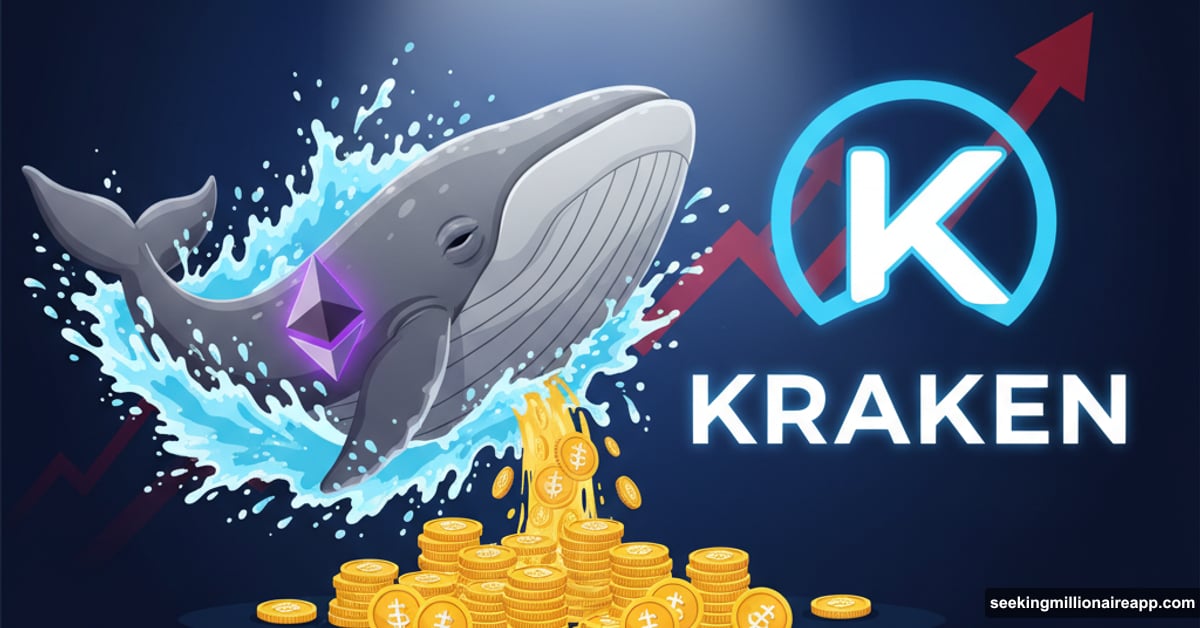An old-school Ethereum holder just broke two years of silence. And they brought $20 million worth of ETH to an exchange.
That’s rarely a good sign for short-term prices. When whales move big stacks to trading platforms, they’re usually preparing to sell. Plus, this isn’t their first rodeo this year.
The Numbers Tell a Story
On-chain analytics firm Nansen tracked the moves. One wallet address dumped 4,500 ETH onto Kraken on October 5th. At current prices, that’s roughly $20.4 million walking through the door.
But here’s where it gets interesting. This same address has been steadily moving coins for four months. They’ve transferred 5,502 ETH total, worth about $23.38 million. Yet they still hold 3,051 ETH valued at $13.8 million.
So why move some but not all? That’s the million-dollar question keeping traders up at night.
Why Dormant Whales Matter
When early Ethereum holders wake up, markets pay attention. These OG wallets typically bought ETH under $100. For them, any price above $4,000 represents absurd profits.
Most long-term holders follow a pattern. They accumulate during bear markets when everyone’s panicking. Then they distribute during bull runs when retail investors pile in. It’s textbook market psychology.
This particular whale sat quiet for two years. No movements, no sells, nothing. Then suddenly they start depositing to exchanges right when ETH faces resistance around $4,500.
The timing raises eyebrows. Are they reading the same charts as everyone else? Do they know something the market doesn’t?
What This Means for ETH Prices
Large deposits like this create selling pressure. It’s simple supply and demand. When millions of dollars worth of ETH hit exchange wallets, buyers need to absorb that supply or prices drop.
Recent trading sessions show ETH bouncing between $4,000 and $4,200. If this whale dumps their remaining holdings, those support levels face serious tests. Technical traders watch these zones closely for breakdown signals.
Volume spikes matter too. Big whale movements often trigger increased trading on pairs like ETH/USDT and ETH/BTC. That liquidity surge creates opportunities for day traders and scalpers looking for quick entries and exits.
However, selling pressure isn’t guaranteed. Sometimes whales move coins to exchanges for other reasons. Staking, lending, or portfolio rebalancing can all trigger large transfers without immediate price impact.
Reading the Blockchain Tea Leaves
On-chain data providers like Nansen give traders an edge. Instead of guessing what big players might do, you can watch their actual wallet movements in real-time.
Smart traders set alerts for transfers exceeding 1,000 ETH. When notifications hit, they check the destination. Moves to exchanges? Potential sell signal. Transfers to cold storage? Possible accumulation phase.
This specific wallet’s behavior shows methodical selling. Four months of consistent deposits suggests a strategy, not panic. They’re gradually distributing their holdings rather than dumping everything at once.
That measured approach limits immediate price impact. But it also means selling pressure could continue for weeks or months as they unload their remaining 3,051 ETH.
Trading the Whale Waves
So how should traders respond? Several strategies make sense depending on risk tolerance.
Conservative players might wait and watch. If ETH approaches its 50-day moving average during this selling pressure, that could signal a buy-the-dip opportunity. Assuming no broader market collapse happens, those pullbacks often reverse quickly.
Aggressive traders could short near resistance levels. If the whale keeps depositing and ETH can’t break $4,500, shorting with tight stop-losses above recent highs offers favorable risk-reward ratios.
Risk management matters most. Stop-loss orders below recent lows around $3,800 protect against unexpected dumps. No one knows exactly when or how much this whale will sell next.
Cross-market correlations factor in too. Ethereum’s price often mirrors Bitcoin’s movements. If BTC rallies strongly, it could offset any downward pressure from whale selling. Monitor Bitcoin dominance metrics for clues about broader crypto sentiment.
The Bigger Picture Nobody Mentions
This whale’s actions happen against a backdrop of major Ethereum developments. Layer-2 scaling solutions are maturing. Staking yields remain attractive. Institutional adoption continues growing.
Yet old holders selling into strength isn’t unusual. They bought at much lower prices and want to realize gains. That’s completely rational behavior, not a bearish signal about Ethereum’s long-term prospects.
Markets need both buyers and sellers. Whale distributions transfer coins from diamond hands to new holders who believe in current valuations. This natural rotation process helps price discovery work efficiently.
Still, short-term traders face volatility risks when big players move. The next few weeks will reveal whether this whale’s selling finds eager buyers or pushes prices lower first.
Watch that wallet address closely. Another large deposit could signal more selling ahead. But if transfers stop, the selling pressure might be finished.
Either way, this old-school Ethereum holder just reminded everyone that whales still control significant supply. And when they decide to move, markets react whether we like it or not.
